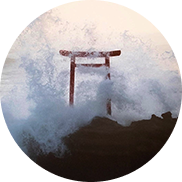Torii
Perhaps one of the most famous symbols of Shintoism are the majestic portals that mark the entrance to the shrines. Made of wood or stone, the portals with two pillars are called “torii” and delimit the area inhabited by a kami. The act of passing through a torii is seen as a form of purification, which is very important when visiting a shrine.
In Japan, the color red represents the sun and life, and is also said to ward off bad omens and disasters. Once again, by passing through these portals, visitors are cleansed of any bad energy, ensuring that only good energy is brought to the Kami who resides there.
There are a variety of toriis made from unlacquered wood, stone (usually white or gray) and even metal. Although there are a large number of color variations, there are an even larger number of shapes (somewhere around 60). The two most common types, however, are “myojin” and “shinmei”. Myojin torii are curved upwards at their ends and have a beam that extends beyond the posts. Shinmei torii have a straight top and a crossbar that ends at each post.


